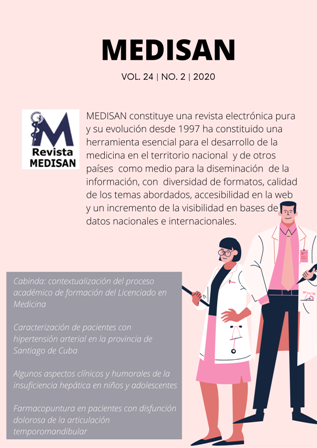Biomarkers as prediction factors of breast cancer by means of a posteriori implicative analysis
Keywords:
biomarkers, breast cancer, prognosis, implicative statistical analysis, posteriori statistical analysis.Abstract
Introduction: Biomarkers are substances that are increased in the organism if tumors exist. To demonstrate how they influence in the mortality it is necessary an analytic study where statistical techniques are involved as the implicative statistical analysis.
Objectives: To determine the influence of biomarkers as prediction factors of mortality due to breast cancer and to demonstrate the validity of a posteriori analysis as a phase in the methodology of the implicative statistical analysis implementation.
Methods: A cases and controls analytic study of 75 patients older than 18 years with clinical and histological diagnosis of breast cancer was carried out, they were assisted in Conrado Benítez García Teaching Provincial Cancer Hospital in Santiago de Cuba, from 2014 to 2019. The foreseen phases were followed to implement this form of analysis and the implicative grapho and the similarity and cohesion trees were obtained.
Results: It was verified that the relationship between the biomarkers and the alive patients was due to B luminal subtype. Also, in the meta-rules that includes dead women, B luminal subtype was involved, while the A luminal subtype was part of this meta-rule; the other subtypes didn't form rules with any other factor.
Conclusions: The necessity and importance of the posteriori analysis phase was demonstrated, where the existence of some prediction factors was confirmed and others found before were rejected.
Downloads
References
2. Daniels B, Kiely BE, Tang M, Tervonen H, Pearson SA. Trastuzumab use in older patients with HER2-positive metastatic breast cancer: outcomes and treatment patterns in a whole-of-population Australian cohort (2003–2015). BMC Cancer 2019 [citado 10/10/2019];19(1):909. Disponible en: https://www.ncbi.nlm.nih.gov/pmc/articles/PMC6740010/
3. Healey MA, Hirko KA, Beck AH, Collins LC, Schnitt SJ, Eliassen AH, et al. Assessment of Ki67 expression for breast cancer subtype classification and prognosis in the Nurses’ Health Study. Breast Cancer Res Treat. 2017 [citado 20/06/2019];166(2):613–22. Disponible en: https://doi.org/10.1007/s10549-017-4421-3
4. Esteva FJ, Hortobagyi GN. Prognostic molecular markers in early breast cáncer. Breast Cancer Res. 2004 [citado 21/06/2019];6(3):109-18. Disponible en: http://breast-cancer-research.com/content/6/3/109
5. Sagaró-del-Campo N, Zamora-Matamoros L. Análisis estadístico implicativo versus Regresión logística binaria para el estudio de la causalidad en salud. MULTIMED. 2019 [citado 11/12/2019];23(6):1416-40. Disponible en: http://www.revmultimed.sld.cu/index.php/mtm/article/view/1435
6. Sagaró-del-Campo NM, Zamora-Matamoros L. ¿Cómo aplicar el análisis estadístico implicativo en los estudios de causalidad en salud? Revista Electrónica Dr. Zoilo E. Marinello Vidaurreta. 2020 [citado 26/01/2020];45(1). Disponible en: http://revzoilomarinello.sld.cu/index.php/zmv/article/view/1960
7. Arroyo Yustos M, Martín Angulo M, Álvarez-Mon Soto M. Cáncer de mama. Medicine. 2017 [citado 10/10/2019];12(34):2011-23. Disponible en: https://www.medicineonline.es/es-cancer-mama-articulo-S0304541217301282
8. Martín M, Herrero A, Echavarría I. El cáncer de mama. Arbor. 2015 [citado 10/10/2019];191(773):234. Disponible en: http://dx.doi.org/10.3989/arbor.2015.773n3004
9. Tao Z, Shi A, Lu C, Song T, Zhang Z, Zhao J. Breast Cancer: Epidemiology and Etiology. Morphological and Molecular Classification of Breast Tumors Cell Biochem Biophys 2015;72:333–8.
10. Arnedo Franco G. Análisis de sobrevida relacionada con factores pronósticos en mujeres con cáncer de mama tratadas en un Centro Cancerológico de la ciudad de Barranquilla 2011-2016 [tesis de maestría]. Barranquilla; Universidad del Norte; 2018 [citado 20/10/2019]. Disponible en: http://manglar.uninorte.edu.co/handle/10584/8123
11. Hashmi AA, Hashmi KA, Irfan M, Khan SM, Edhi MM, Ali JP, et al. Ki67 index in intrinsic breast cancer subtypes and its association with prognostic parameters. BMC Res Notes. 2019 [citado 20/10/2019];12:605. Disponible en: https://doi.org/10.1186/s13104-019-4653-x
12. Díez González L. Estudio de factores biológicos implicados en el pronóstico de cáncer de mama mediante meta-análisis de datos publicados [tesis doctoral]. Albacete: Universidad de Castilla-La Mancha; 2015 [citado 20/10/2019]. Disponible en: https://ruidera.uclm.es/xmlui/handle/10578/7116?show=full
13. Panal Cusati M, Herrera de la Muela M, Hardisson Hernaez D, Choqueneira Dionisio M, Román Guindo A, de Santiago Garcia FJ. Correlación entre la expresión de Ki67 con factores clásicos pronósticos y predictivos en el cáncer de mama precoz. Rev Senol Patol Mamar. 2014 [citado 20/10/2019];27(4):163-9. Disponible en: http://dx.doi.org/10.1016/j.senol.2014.07.005
14. Won Woo J, Ri Chung Y, Ahn S, Kang E, Kim EK, Kim SH, Kim JH, Kim IA, Park SY. Changes in Biomarker Status in Metastatic Breast Cancer and Their Prognostic Value. J Breast Cancer. 2019 Sep [citado 20/10/2019]22(3):439-52. Disponible en: https://doi.org/10.4048/jbc.2019.22.e38
Published
How to Cite
Issue
Section
License
All the articles can be downloaded or read for free. The journal does not charge any amount of money to the authors for the reception, edition or the publication of the articles, making the whole process completely free. Medisan has no embargo period and it is published under the license of Creative Commons, International Non Commercial Recognition 4.0, which authorizes the copy, reproduction and the total or partial distribution of the articles in any format or platform, with the conditions of citing the source of information and not to be used for profitable purposes.





